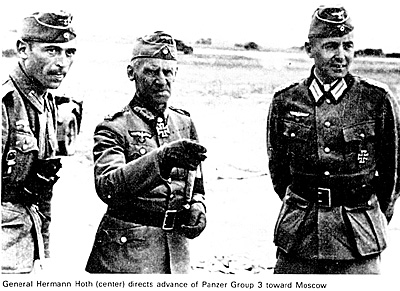
In the overall context of the Barbarossa campaign, the German thrust toward Leningrad and the Kiev encirclement overshadowed Army Group Center's defensive stand. The successful execution of these operations, which pulverized Russian concentrations on both flanks of the front, seemed at the time a reasonable return for Army Group Center's ordeal.
General Hermann Hoth (center) directs advance of Panzer Group 3 toward Moscow.
Reinforced by panzer elements stripped from Army Group Center, Leeb's Army Group North advanced to the Lake Ladoga-Volkhov River-Lake IlmenValdai Hills-Demyansk line. This drive drained the German tank and motorized infantry forces, whose progress was slowed by marshy, forested terrain and desperate Soviet resistance. Relentless Soviet night counterattacks denied rest to the exhausted German assault troops, and even soldiers of the elite Waffen SS Totenkopf Division grumbled that the grueling routine of attacking by day and defending by night was becoming unendurable. [91]
Nevertheless, by early September, the German advance had cut Leningrad's land communications, and Leeb's units stood poised to capture the city. At this point, however, Hitler again asserted his strategic prerogative by ordering that Leningrad not be stormed. Instead, the Fuhrer ordered German troops merely to invest Leningrad and allow it to fall of
its own weight. [92]
In the south, the encirclement of Soviet forces in the Kiev salient produced the most spectacular Kessel victory to date: 665,000 prisoners, 824 tanks, and 3,018 artillery pieces fell into German hands by 26 September. [93]
Until the Kiev caldron could be liquidated by the infantry units of the German Second and Sixth Armies, the usual difficult defensive battles were fought by the panzer and infantry divisions forming the encircling rings. In describing Soviet breakout attempts, General Halder wrote on 17 September that "the encircled enemy units are ricocheting like billiard balls within the ring closed around Kiev." [94]
Even as the strangulation of Leningrad and the reduction of the Kiev pocket were underway, Hitler, flushed with success, on 6 September ordered German forces to reconcentrate in the Army Group Center sector for a belated attack on Moscow.
Adolf Hitler's turnabout decision to attack Moscow did not stem from any last-minute conversion to the strategic views of his military advisers. Rather, the impending victories at Leningrad and Kiev had fired Hitler's imagination, prompting him to envision a renewed grand advance into the Russian depths.
The centerpiece of this effort was to be a new series of Kessel battles by Army Group Center that would destroy the Soviet armies ranged before Moscow. In the south, Field Marshal Gerd von Rundstedt's Army Group South would drive into the void created by the Kiev victory, aiming toward Kharkov, Rostov, and the Don Basin industrial area. Leeb's Army Group North would continue to throttle Leningrad while protecting the northern flank of Army Group Center. [95]
In Hitler's mind, these strategic projections constituted the final, triumphal phase of Barbarossa: the crushing of the last Red Army field forces, the capture of the enemy capital, and the plundering of Russian economic wealth.
Most German commanders endorsed the concept of an attack on Moscow, though they regarded it to be a far more precarious operation than did the ebullient Fuhrer. Their concern stemmed from the reduced combat and logistical capacity of German forces, the continuing resistance of the Red Army, and the approach of the autumnal rainy season, all of which lengthened the odds against a successful offensive.
Weakened by the defensive battles against Timoshenko and Zhukov, Army Group Center, in particular, was incapable of early offensive action unless heavily reinforced. Since nearly all German divisions in Russia were already committed, reinforcements could only be mustered by disengaging units from other parts of the front and redeploying them
into the Army Group Center area. Such a reshuffling of German forces would cause
tremendous logistical and command difficulties and would fritter away most of the
remaining good weather as well. Hitler, however, discounted these difficulties, remarking
airily on 5 September that the Moscow attack "should if possible be launched within 8-10 days." (This estimate was so impossibly optimistic that Halder promptly dismissed it as "impossible." [96]
As Hitler remained adamant in his demands for immediate action, the second half of September was spent moving German forces into position for Operation Taifun, the name of the Moscow attack. In all, more than 25 divisions joined, or rejoined, Army Group Center. This maneuvering further snarled German communications as units
crisscrossed each other's supply lines.
Not all units earmarked for the Moscow attack could even be concentrated by the 2 October start date: Guderian's Panzer Group 2 had to be given an independent, more southerly axis of advance in order to shorten its return march from the Kiev battles, while some panzers returning from Army Group North arrived too late to participate in the opening phases of the attack. [97] So confused was the shifting of units that Hoth's Panzer Group 3 and General Erich Hoepner's Panzer Group 4 actually swapped their entire
commands during the month of September. [98]
Luckily for the Germans, the Soviets did little to interfere with these offensive preparations. Red Army forces facing Army Groups Center and South were themselves weakened from the battles of August and early September, and they used this time to restore their own strength.
Only on the Army Group North front did the Russians remain active, launching a series of sharp attacks in the hope of breaking the German grip on Leningrad. Between 18 and 28 September, for example, a flurry of Soviet attacks buckled the thin lines of the Waffen SS Totenkopf Division south of Lake Ilmen. German losses in this fighting were so heavy-one SS battalion lost 889 men, including all of its officers, between 24 and 29
September-that the division commander warned on 29 September that the continued combat worthiness of his unit was in doubt. [99]
The 30th Infantry Division, dug in on the left of the Totenkopf, likewise defended itself against seemingly endless waves of Russian tanks and infantry. Effective defense was plagued by the same ailments as existed elsewhere: an excessively wide division frontage (over thirty kilometers for the 30th Infantry Division), defensive positions consisting of only a single trenchline without depth or obstacles, and no reserves. After German artillery successfully crushed several Russian breakthroughs, the Soviets switched their tactics to create shallow penetrations of great width.
This left the Germans no choice but to close these gaps by counterattack, suffering heavy casualties in doing so. In this way, the 30th Division lost 31 officers and 1,440 enlisted men in three weeks of nightmarish defensive fighting.
[100]
The German drive on Moscow began on 2 October and immediately developed
"on a truly classic pattern." [101] Three German panzer groups smashed through the Soviet defenses and enclosed more than six Soviet armies in two great caldrons at Vyazma and Bryansk. Though made purposely shallow in order to spare the panzer forces the agony of prolonged defensive fighting, these pockets yielded more than 550,000 prisoners by the third week of October. [102] As in previous Kessel battles, German units fought many extemporaneous defensive engagements in order to contain trapped Red Army divisions. [103] Soviet relief attacks from outside the pockets failed to materialize, however. The German pincers had enclosed the bulk of the combat-worthy Russian units guarding Moscow, and the few that remained outside of the pockets were busy forming a new defensive line in front of the Soviet capital. [104]
These successes so heartened General Halder that the chief of the Army General Staff
predicted in his diary on 8 October that "with reasonably good direction of battle [that is, no
fatal interference by Hitler] and moderately good weather, we cannot but succeed in encircling Moscow." Halder's optimism was echoed by Otto Dietrich, the Reich press chief, who announced on 9 October that "for all military purposes, Soviet Russia is done with." [105]
The optimism following the battles of Vyazma and Bryansk was premature. Heavy rains began on 7 October and continued through the remainder of the month, turning the Russian countryside into a quagmire and stifling Army Group Center's offensive operations. German forces continued to slog ahead here and there, with tactical progress being made with great difficulty. However, the mud paralyzed the German logistical system, which
depended entirely on motorized and horse-drawn vehicles to draw supplies overland from the rearward railheads.
While the muddy season also dampened Soviet operations, the Russians enjoyed two important advantages over their enemies: a shorter line of communications and a nearly intact rail net. The rain-induced pause that suspended major operations for five crucial weeks in October and November thus worked greatly to the Soviets' advantage. When German attacks over frost-hardened ground resumed on 14 November, the way to Moscow
was again barred by fresh Red Army forces and formidible defensive works.
On the southern portion of the front, Field Marshal von Rundstedt's Army Group South successfully sustained its offensive drive. General Ewald von Kleist's First Panzer Army* (*1st and 2d Panzer Groups were redesignated panzer armies on 5 October 1941.) formed the cutting edge of the southern attack and advanced rapidly along the Azov coast toward Rostov.
Rain, mud, and Soviet counterattacks slowed the advance of the Seventeenth Army and Sixth Army ranged on Kleist's northern flank, which resulted in the German armored spearhead virtually losing contact with the infantry forces echeloned to its rear. Despite his progress, Rundstedt doubted the German ability to crush the remaining Red Army forces facing him and to reach the far-flung territorial objectives demanded by Hitler. Rundstedt unsuccessfully urged that German
operations on the southern front be curtailed. [106]
The German III Panzer Corps seized Rostov on 20 November, capturing intact a bridge over the Don River leading to the Caucasian oil-producing regions coveted by Hitler. [107]
Immediately, Russian counterattacks began to tear at the German salient at Rostov from three sides, while other Red Army forces swept down into the gap between the First Panzer Army and the Seventeenth Army. On 28 November, with Army Group South's offensive energies exhausted and with no strategic purpose to be served by holding Rostov in a risky defensive battle against superior Soviet forces, Rundstedt ordered First Panzer
Army to withdraw to the Mius River where a winter defensive line could be consolidated. [108] This proposal was militarily prudent and conformed to the German defensive tradition of conserving combat power while not holding terrain for its own sake.
Hitler, however, did not regard strategic problems in traditional ways. In the German dictator's mind, the prestige value of holding Rostov outweighed any risk that German forces might have to endure in order to hold it. On 30 November, after a vitriolic conversation with Brauchitsch, Hitler countermanded Rundstedt's withdrawal order by directing that German forces stand and fight on the Don. Affronted at this interference in his command, Rundstedt asked to be relieved. Hitler promptly granted Rundstedt's request and named Field Marshal Walter von Reichenau as the new commander of Army Group
South. [109]
The change in army group leadership, however, did not alter the tactical situation around Rostov. Russian pressure against First Panzer Army overwhelmed Reichenau's attempts to hold forward defensive positions, and on 1 December, Hitler allowed Army Group South to fall back to the Mius defensive line, which was the position that had been advocated by Rundstedt earlier. Of Hitler's obstinacy and interference, Halder noted with grim satisfaction that "now we are where we could have been last night. It was a senseless waste of time, and to top it, we lost Rundstedt also." [110]
First Panzer Army's defensive efforts at Rostov and during the withdrawal to the Mius line were harrowing. In fact, the fighting retreat of the German southern wing might have ended disastrously had it not been for heavy Luftwaffe attacks against the advancing Soviets. [111] Kleist's panzer army was composed almost entirely of armored and motorized infantry formations which, as previously explained, were inherently less able to hold ground than were German infantry divisions. This problem was exacerbated by the increasing appearance of new Soviet T-34 tanks, against which the German tank and antitank guns made little impression. In one case, the German 60th Motorized Infantry Division had some of its Paks literally "rolled flat" by T-34s during defensive fighting within Rostov itself. [112]
In addition, the German forces held an excessively broad defensive front and did so with units that were badly depleted in strength. The III Panzer Corps, for example, initially held its 100-kilometer-long perimeter around Rostov with only one panzer and two motorized divisions. [113] Russian attacks,
characterized by Halder as "well-led" and "numerically far superior," inflicted heavy casualties on these thinly spread German units. [114]
On 22 November, for example, the 16th Panzer Division could muster only 350 riflemen in its defensive positions guarding the German flank north of Rostov. Heavy Soviet assaults cost one of the 16th Panzer Division's weakened infantry battalions seventy men in one day, a loss that decimated that unit. [115] The temperature,
which dipped to more than -200C, diminished the obstacle value of streams and rivers by freezing them solid and rendered the ground so hard that defensive positions could only be gouged out with explosives.
Finally, the smooth withdrawal of German forces to the Mius line was interrupted by Hitler's temporary "stand and fight" order. This order reached German forward units after the retreat had already begun, thus resulting in considerable confusion during the following two days as combat forces and rear-echelon service units became entangled in marches and countermarches. [116]
By the end of the first week of December, Army Group South had established a winter defensive line running generally from the Mius River north along the Donets River. Likewise, the Army Group North positions had stabilized in a vast salient extending from Leningrad eastward to Tikhvin and then south to Lake Ilmen and the Valdai Hills. The lines of Leeb's army group fell short of the goal set by Hitler of linking up with the Finns, but no
further offensive actions could be expected. Only on the central portion of the front did the
Germans cherish hopes of further offensive success.
Bock's Army Group Center had surged forward on 15 November in a last,
desperate grab for Moscow. This attack had immediately collided with prepared Soviet defenses manned by newly reinforced Russian armies. Dogged by a deficient logistical system, severe shortages in personnel and equipment, and the onset of harsh winter weather, the German offensive made slow progress. Although Hitler wildly urged Bock to undertake deep envelopments, the fact remained that the armies of Army Group Center had so dwindled in strength and mobility that only frontal attacks could be mounted. [117]
By the end of the month, German units had reached the extreme limit of their endurance. Although the maps in Hitler's headquarters still portrayed a great offensive, at the front the scattered and feeble thrusts by German units increasingly resembled the reflexive spasms of a dying animal. [118]
Even before their hopes of capturing Moscow totally died away, German planners
hastened to assess the requirements for extended defensive operations through the Russian
winter. Whatever the outcome of the Moscow battles, the German armies in, Russia would be unable to conduct new offensive operations until the following spring. Consequently, as it became apparent that no final Soviet collapse or capitulation was going to occur, German staff officers bent their efforts to planning for a winter defense on the Russian Front.
As early as 19 November, with Operation Taifun still in full swing, Hitler conferred with his military advisers on the building of an "east wall" defensive line, but the dictator put off any decision until a later date. Four days later, Halder discussed the construction of a rearward defensive line and fortifications with General Hans von Greiffenberg, Army Group Center's chief of staff.
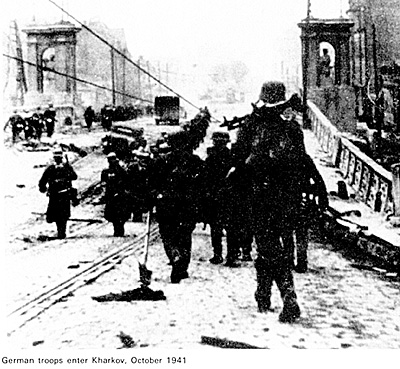 German troops enter Kharkov, October 1941.
German troops enter Kharkov, October 1941.
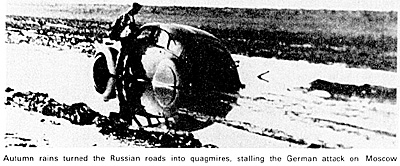 Autumn rains turned the Russian roads into quagmires, stalling the German attack on Moscow.
Autumn rains turned the Russian roads into quagmires, stalling the German attack on Moscow.
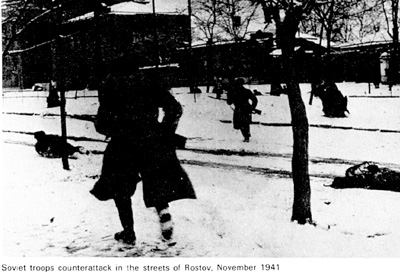 Soviet troops counterattack in the streets of Rostov, November 1941
Soviet troops counterattack in the streets of Rostov, November 1941
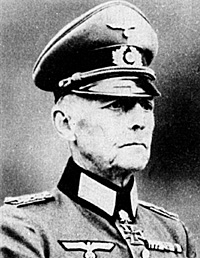 Field Marshal Gerd von Rundstedt, commander of Army Group South.
Field Marshal Gerd von Rundstedt, commander of Army Group South.
Back to Table of Contents -- Combat Studies Research # 3
Back to Combat Studies Research List of Issues
Back to MagWeb Master Magazine List
© Copyright 2005 by Coalition Web, Inc.
This article appears in MagWeb.com (Magazine Web) on the Internet World Wide Web. Other articles from military history and related magazines are available at http://www.magweb.com